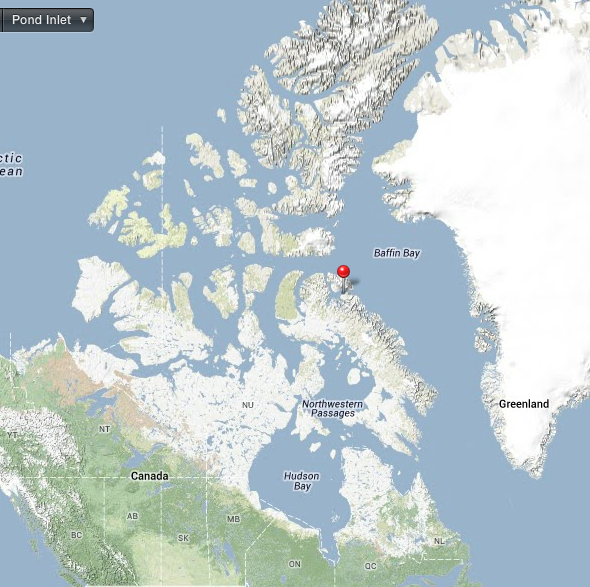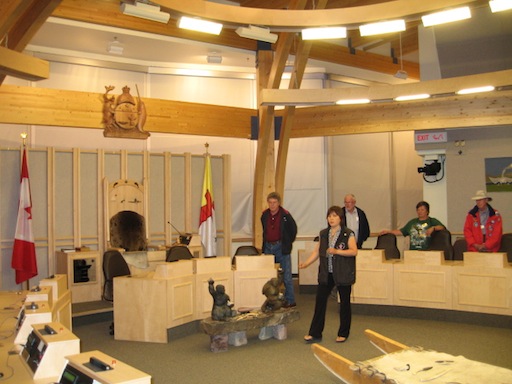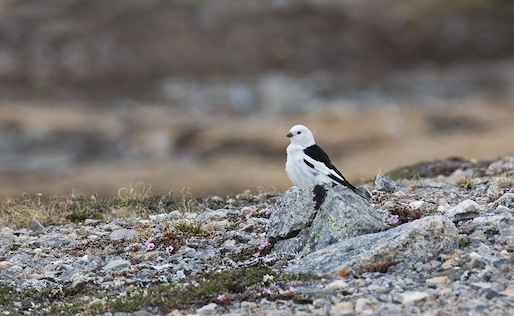
Where We Are Tonight
Pond Inlet, Nunavut

|
In the hotel lobby, I immediately recognized Kate and also got to meet two of
our other companions, Emma and John. Later at the airport, I met Mary, Jo,
Jenny and Graham, and Margaret and Graham. They are all British and seem to be
pleasant and interesting and accomplished, mostly academics. Many have traveled
with Mark before. (There will be only thirteen of us in the group in addition
to Mark and the guides from Arctic Kingdom.)
Waiting in the departure lounge, I savored what will likely be my last Diet Coke for the week. (The others will be deprived of alcohol in Nunavut, as many of the communities there have strong prohibition laws.) |
|
The first leg of our trip was from Ottawa to Iqaluit, the capital of the
Canadian federal territory of
Nunavut, which was
formed in 1999. “Nunavut” means “our land” in
Inuktitut, the language of the Inuit people. Inuktitut is the predominant
language in Nunavut. Pre-recorded announcements on our flights (such as,
“Do not leave the plane before the propellers stop”) were given
in English, French, and Inuktitut.
The importance of the Narwhal to the people of Nunavut is shown by its prominence on the Nunavut coat of arms, co-equal with the Caribou. The flight to Iqaluit went smoothly. I spent the time re-reading A Naturalist’s Guide to the Arctic by E.C. Pielou. I first read it five years ago at Tiffany’s suggestion but needed a refresher, especially the parts about Arctic landforms. I pleased myself by spotting solifluction lobes on the side of one mountain we flew over, just minutes after I’d read about them. Looking out now and then, I first saw green land with many ponds and lakes, the relics of past Ice Ages. Then the next time I looked out, all was white and blue. How I love the Arctic! (Many of the other folks in the group seem to have been bitten by the Arctic bug, too.) |
 Nunavut Coat of Arms |
| When we landed at Iqaluit, we began seeing signs in the graceful syllabary used for writing Inuktitut: |
|
|
|
| For our one-hour layover in Iqaluit, we were met by a minder from Arctic Kingdom, who said he could take four of us at a time to visit the center of town and see the legislative building. Since I’d been there before and some of the others hadn’t, I stayed in the airport and took advantage of the opportunity to view the Inuit art display. (I can recall regretting being rushed past it when we flew into Iqaluit five years ago.) |
|
The Legislative Assembly’s building is well worth a visit. I remember
particularly the Narwhal tusks on the premier’s sealskin-covered chair.
 Nunavut Legislative Chamber |
 Premier’s Chair |
|
Our next flight was on a 20-passenger prop-jet operated by First Air. (Here is
a
map
for following the rest of our journey through Nunavut, up the east coast of
Baffin Island from Iqaluit to Clyde River to Pond Inlet.) The flight attendant
was a charming, but no-nonsense Parisienne, who didn’t let us get away
with having anything loose in the plane during takeoff and landing.
The land we flew over was a partially-drowned mountain range, the sea coming in between the mountains as fjords or as inlets that isolated the mountains into a jumble of islands. Many of them were topped with glaciers, and all the water I could see from the left side of the plane was frozen. |
|
|
|
| The plane had a refueling stop at Clyde River, about half the way up Baffin Island. This was our first gravel runway of the trip. We were all asked to get off for the refueling, so went out to explore in front of the airport, where I tried to spot the Ravens I thought I’d seen as we were landing. We found a friendly little dog tied to an ATV and later watched it trot off very happily when its family drove away. |
|
|
|
|
Mark was on hand to greet us at the airport, along with Tom Lennartz, the
expedition leader for Arctic Kingdom. With them was the final member of our
group, Sarah, who has been in Pond Inlet for a couple of days.
We loaded our bags onto vehicles for the short trip to the hotel and then walked from the airstrip to the hotel, doffed our shoes to keep from tracking in the omnipresent sand, dropped our things in our rooms, and headed for the hotel dining room for dinner and orientation. (Well, I first took the time to connect my iPhone to the hotel’s wifi to let Lee know I’d arrived, but he’d been watching online and already knew that the plane had landed. I was glad of the three emails he’d sent, as I have had no cellphone signal since we left Ottawa — thanks, AT&T — so I can’t talk with him.) We were given a warm welcome by Rita, who manages the hotel and does the cooking. She had prepared a good hot roast turkey dinner for us. Tom admitted at dinner that the requirement that we bring along biodegradable toothpaste was a mistake. He took a bit of ragging about it, as each of us had struggled to meet that requirement and those of us who succeeded had come to regret our success. After dinner, Tom and Mark both spoke about the logistics of the trip, which appears to be very well organized. Each of us was given a water bottle and an insulated mug to use to keep ourselves hydrated in the dry Arctic air. “These will be your friends for the week.” |
 Tom Lennartz |
| After dinner, we adjourned to the Nattinnak Centre, the hamlet’s visitor and cultural center. It is a very handsome building designed to resemble the icebergs that float in Eclipse Sound below it in the summer after the ice floe melts. (The turquoise trim echoes, but doesn’t quite duplicate, the glorious color one sees in the depth of icebergs.) |
|
|
|
| From the windows of the cultural center, we could look out onto the ice of the sound, which serves as a sort of livingroom for the town at this time of year. The town’s dog teams are kept out there to reduce the mess. All over the ice there were Ravens and Glaucous Gulls scavenging the dogs’ food (seal meat). |
|
|
|
| As we walked back to the hotel, I could hear Snow Buntings singing and then managed to see some. Mark pointed out a Snow Bunting nest he’d spotted on one of the houses. I paused to photograph a dead Raven nailed to a house to discourage live Ravens from messing with the skins that were being dried nearby. |
 Male Snow Bunting Spitsbergen (Photo courtesy of John Chapman) |
Scare-raven |
| Back in our room, Kate and I got our luggage organized so that we’ll be able to pull out extra layers easily should our long trip along the ice tomorrow turn cold. I’m sure I’m too excited to get much sleep tonight. What a week it’s been! |
